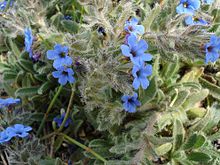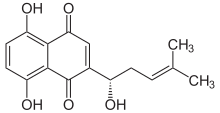Make-up root
| Make-up root | ||||||||||||
|---|---|---|---|---|---|---|---|---|---|---|---|---|

Make-up root |
||||||||||||
| Systematics | ||||||||||||
|
||||||||||||
| Scientific name | ||||||||||||
| Alkanna tinctoria | ||||||||||||
| ( L. ) Exchange |
The make-up root ( Alkanna tinctoria ), and Dyer's Alkanna called, is a species of the genus Alkanna within the family Boraginaceae (Boraginaceae).
description
The make-up root is a perennial herbaceous plant that reaches heights of 10 to 30 centimeters. It is bristly gray haired and mostly glandless. The lower leaves are bristly, obovate and sessile, the upper ones are smaller and narrowly ovoid. The narrow, egg-shaped bracts are about as long as the bristly calyx. The petals are bright blue, outside glabrous and at the edge the crown is 4–10 millimeters wide.
The flowering period extends from May to June.
The number of chromosomes is 2n = 30.
Systematics and distribution
The Basionym Lithospermum tinctorium was first described in 1753 by Carl Linné in Sp. Pl .: 132. In 1824 Ignaz Friedrich Tausch placed the species in the genus Alkanna and renamed Alkanna tinctoria in Flora or Botanische Zeitung, Volume 7, page 234 .
According to "Euro + Med" 2011, the following are synonymous: Alkanna bracteolata Greuter , Alkanna lehmannii (Tineo) A.DC. , Alkanna matthioli Tausch , Alkanna tuberculata (Forssk.) Meikle non Greuter , Alkanna tuberculata Greuter , Alkanna tuberculata Greuter , Anchusa bracteolata Viv. , Anchusa tuberculata Forssk. , Buglossum tinctorium (L.) Lam. , Lithospermum lehmannii Tineo , Lithospermum tinctorium L. , Lycopsis cyrenaica Spreng. nom. illeg., Alkanna tinctoria subsp. lehmannii (Tineo) Nyman , another is Anchusa tinctoria (L.) L.
Alkanna tinctoria occurs with five subspecies in Hungary , Slovakia, southern Europe , western Asia and northern Africa .
One can distinguish several subspecies:
- Alkanna tinctoria subsp. anatolica Hub.-Mor. : It was first described in 1971 and occurs in Crete in the Aegean Sea and in the Asian part of Turkey .
- Alkanna tinctoria subsp. glandulosa Hub.-Mor. : It was first described in 1977 and occurs in the Asian part of Turkey.
- Alkanna tinctoria subsp. subleiocarpa (Hub.-Mor.) Hub.-Mor. (Syn .: Alkanna subleiocarpa Hub.-Mor. ): This new combination took place in 1978. It occurs in the Asian part of Turkey and on the islands of the Aegean Sea.
- Alkanna tinctoria subsp. tripolitana (Bornm.) Qaiser (Syn .: Alkanna tripolitana Bornm. ): This new combination took place in 1979. It occurs only in Libya .
- Alkanna tinctoria exchange subsp. tinctoria : It occurs in North Africa, in Southern Europe, in Southeast Europe and in the Middle East .
Ingredients and usage
The bark of the roots contains 5 to 6 percent alkannin and some alkannan . In addition, the red pigments anchusa red and alkane red are also found there . Parts of plants are therefore used to obtain dyes, from which the name common name is derived.
In ancient times the make-up root was used to dye wool and as a component of make-up . It was also used as a substitute for snail purple. The underground parts of the plant are harvested in spring or autumn.
Common names
There are various common names , such as Dyeing Ox Tongue and False Alkanna. The names alkanna root, alkeruen root, blood root, red dye herb, hurricane, hurricane root, Turkish redness, red dye herb and red tongue are or were also used for make-up root.
Web links
- Alkanna tinctoria at Useful Temperate Plants.
- Data sheet at Wildflowers of Israel .
- Thomas Meyer, Michael Hassler: Mediterranean and Alpine flora. Datasheet and photos .
Individual evidence
- ↑ Peter Schönfelder , Ingrid Schönfelder: The new cosmos Mediterranean flora. Franckh Kosmos Verlag Stuttgart 2008. ISBN 978-3-440-10742-3 . P. 136.
- ↑ Alkanna tinctoria at Tropicos.org. In: IPCN Chromosome Reports . Missouri Botanical Garden, St. Louis
- ↑ a b c d e Benito Valdés, 2011: Boraginaceae. : Datasheet Alkanna tinctoria Tausch In: Euro + Med Plantbase - the information resource for Euro-Mediterranean plant diversity.
- ^ Alkanna in the Germplasm Resources Information Network (GRIN), USDA , ARS , National Genetic Resources Program. National Germplasm Resources Laboratory, Beltsville, Maryland. Retrieved July 19, 2020.
- ↑ Paul Wagler : Ἄγχουσα . In: Paulys Realencyclopadie der classischen Antiquity Science (RE). Volume I, 2, Stuttgart 1894, Col. 2111 f.
- ^ Georg August Pritzel , Carl Jessen : The German folk names of plants. New contribution to the German linguistic treasure. Philipp Cohen, Hannover 1882, page 26 f., Online.

